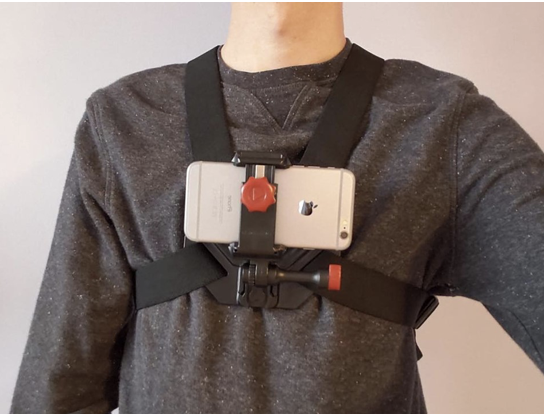
It’s often said that necessity is the mother of invention.
From virtual meetings to curbside pickup, COVID-19 public health measures required many people to change how they do things over the last several months.
They also inspired third-year medical student Lauren Wintraub, and others in the University of Toronto’s Temerty Faculty of Medicine, to think about new ways of using technology in medical education.
Wintraub and a small group of her classmates explored several ways to bridge pandemic gaps in clinical learning with wearable technology. Several innovations show promise, but one in particular stands out: a smartphone mounted on a physician’s chest and connected to Zoom, the videoconference platform.
Medical students couldn’t do clinical skills training in person, so the team brought that experience to them virtually, then assessed the results.
The tech setup allows students to log in to the virtual meeting space and see what the doctor is doing during an exam with a consenting volunteer or patient. If a doctor is examining a patient’s knee, for example, the smartphone camera can provide an unobstructed view of the doctor’s hands on the leg.

Students can also ask the physician questions, and the physician can answer, in real time.
The group first experimented with wrist and head-mounted cameras. But ultimately, they found the chest-mounted smartphone gave the clearest view of the physician’s actions, was the most stable and allowed for a direct internet connection to Zoom.
And the innovation requires little investment, since most physicians already own a smartphone. The chest-mount Wintraub and the team used cost about $65 through a major online retailer.
“The other students in our team are also looking at this tech combination in the context of other educational activities,” says Wintraub. “One project explores longitudinal experiences, and another will test the tool in relation to shadowing. It’s not a replacement for in-person learning, but it’s a great supplement.”
The team, which also included Mary Xie, Mariam Mohamad Issa, Matthew Nelms and Daniel Teitelbaum, recently published their findings in the Canadian Medical Education Journal.
For her work on the project, Wintraub also won a Society of Teachers of Family Medicine Foundation Student Scholar Award, which includes the opportunity to present the team’s work to an international audience.
“If students want to shadow a physician working in a remote, rural community for example, this kind of tool has potential to allow students to do it in an affordable, efficient way,” says Joyce Nyhof-Young, an education scientist and professor of family and community medicine who helped oversee the project.
“Similarly, students from underserved locations could also use it to access learning opportunities in larger centres. This opens the door to explore new ideas for collaborative learning in different environments,” Nyhof-Young says.
Fok-Han Leung, the MD Program’s director of integrated clinical experience for Health in Community, says the pandemic provided a kickstart to examine technology in this new light.
“At this point, many people have accepted that with proper licenses, Zoom and similar platforms are secure for health care. And though there are still some questions around concerns like data security, we can’t let that impede our curiosity,” says Leung, who is also a professor of family and community medicine.
“Had we proposed these kinds of innovations five years ago, we would have only seen the barriers. The time is right to explore new technological options for teaching and this is just the beginning,” Leung says.
Technology was also part of the solution to address physical distancing requirements during learner assessments for third- and fourth-year medical students, called OSCEs or integrated objective structured clinical exams.
These tests evaluate students’ clinical skills in a realistic and repeatable way, using standardized patients trained to portray the history, symptoms and characteristics of a real patient.
MD Program faculty and staff moved the assessments online, so students interacted with standardized patients virtually in encounters that resemble virtual medical appointments.
Similarly, during the 2021 student admissions cycle, MD Program administrators held virtual interviews with medical school applicants using a platform called VidCruiter, in place of on-campus interviews.
The shift to virtual ensured safety for all participants, and reduced travel-related expenses and logistical pressures for applicants.
As COVID-19 cases continue to trend downward, interest in virtual educational experiences is likely to grow. “We were inspired in this direction due to the pandemic,” says Leung. “But even after it, there will be new questions this approach will help answer.”